Analysis of Thursday's deals:
30M chart of the EUR/USD pair

The EUR/USD currency pair showed rather high volatility and multidirectional movements on Thursday. However, this is not surprising, since the results of the European Central Bank meeting were just announced, and it became known that the central bank raised the rate not by 0.25%, as most traders expected, but by 0.5%. This did not help the euro as much, although in this situation one could expect a sharp strengthening of this currency. However, the euro first rose to the level of 1.0269, which had already tried to overcome it twice, and then fell to the level of 1.0156. As a result, the day ends approximately where it began. Of course, tomorrow we can see the continuation of the results of the ECB meeting. European traders did not have enough time for this on Thursday. But in any case, now the technical picture is not the most appealing. The price settled below the ascending trend line and failed to overcome the level of 1.0269 three times. Thus, the upward trend is broken, and the prospects for the euro's succeeding growth remain vague. Moreover, the pair may now stay inside the horizontal channel at 1.0156-1.0269 for some time, which is also not good.
5M chart of the EUR/USD pair

Trading signals on the 5-minute timeframe were very good on Thursday, but the problem is that they were extremely difficult to work out. The pair traded rather sluggishly and formed only two signals during the European trading session. One for short positions near the 1.0190 level, which turned out to be false. The second is near the same level, after which strong growth began. However, this growth began exactly at the time when the results of the ECB meeting were announced, that is, the market reaction could be completely unpredictable and it was better not to take risks. But the next sell signal, when the price rebounded from the area of 1.0269-1.0277, could already be processed. After that, the pair went down about 100 points and rebounded from the level of 1.0156, forming a buy signal. This signal should be used to close shorts (profit 86 points) and open new long positions. Later the pair began to "dance" around the level of 1.0190, settling either above it or below it, but this is normal price behavior within a strong fundamental background. The long should be closed at the first opportunity and no longer work out signals near the level of 1.0190.
How to trade on Friday:
The upward trend has been reversed on the 30-minute timeframe. The euro's growth may resume, as the ECB still raised its key rate by as much as 0.50%. However, now, in order to identify further growth, we should wait for the price to settle above the level of 1.0269. There is also a certain degree of probability of the start of a flat between the levels of 1.0156 and 1.0269. On the 5-minute TF on Friday, it is recommended to trade at the levels of 1.0072, 1.0123, 1.0156, 1.0235, 1.0269-1.0277, 1.0354. When passing 15 points in the right direction, you should set Stop Loss to breakeven. The European Union and America will publish only indexes of business activity in the services and manufacturing sectors. Not the most important reports in the current circumstances, but if the actual values of one or more of them are much lower than forecasts, this may provoke a market reaction.
Basic rules of the trading system:
1) The signal strength is calculated by the time it took to form the signal (bounce or overcome the level). The less time it took, the stronger the signal.
2) If two or more deals were opened near a certain level based on false signals (which did not trigger Take Profit or the nearest target level), then all subsequent signals from this level should be ignored.
3) In a flat, any pair can form a lot of false signals or not form them at all. But in any case, at the first signs of a flat, it is better to stop trading.
4) Trade deals are opened in the time period between the beginning of the European session and until the middle of the US one, when all deals must be closed manually.
5) On the 30-minute TF, using signals from the MACD indicator, you can trade only if there is good volatility and a trend, which is confirmed by a trend line or a trend channel.
6) If two levels are located too close to each other (from 5 to 15 points), then they should be considered as an area of support or resistance.
On the chart:
Support and Resistance Levels are the Levels that serve as targets when buying or selling the pair. You can place Take Profit near these levels.
Red lines are the channels or trend lines that display the current trend and show in which direction it is better to trade now.
The MACD indicator (14,22,3) consists of a histogram and a signal line. When they cross, this is a signal to enter the market. It is recommended to use this indicator in combination with trend lines (channels and trend lines).
Important speeches and reports (always contained in the news calendar) can greatly influence the movement of a currency pair. Therefore, during their exit, it is recommended to trade as carefully as possible or exit the market in order to avoid a sharp price reversal against the previous movement.
Beginners on Forex should remember that not every single trade has to be profitable. The development of a clear strategy and money management are the key to success in trading over a long period of time.
 English
English 
 Русский
Русский Bahasa Indonesia
Bahasa Indonesia Bahasa Malay
Bahasa Malay ไทย
ไทย Español
Español Deutsch
Deutsch Български
Български Français
Français Tiếng Việt
Tiếng Việt 中文
中文 বাংলা
বাংলা हिन्दी
हिन्दी Čeština
Čeština Українська
Українська Română
Română

